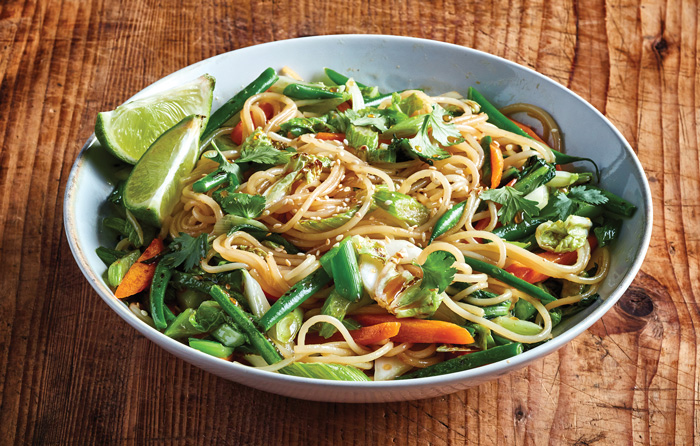
Menu Innovation: PUMPING UP, Paring Down
Confronted with labor shortages, spiraling prices, and cost-conscious consumers, foodservice operators are streamlining and simplifying while staying focused on creative solutions.
Article Content
From pandemic lockdowns to disrupted supply chains to skyrocketing inflation, restaurant operations have been steadily and substantially bombarded with challenges in the past few years. The pressure is on foodservice operators and the companies that supply them with food and beverage products and ingredients to adjust to the current market challenges without compromising on the quality of menu offerings.
The National Restaurant Association reports that 59% of restaurant operators surveyed have changed the food and beverage items featured on their menus. Adaptation is the name of the game, with frequent pivots and an increased focus on versatility, value, feasibility—and the bottom line.
“How feasible are our ideas?” is the question food innovation teams are asking in the face of these ongoing challenges. We spoke with trendspotters, market researchers, product development chefs and consultants, and food manufacturers to get a better understanding of the biggest drivers shaping today’s foodservice innovation pipelines.
The Slow Return to a New Normal
“Consumers are really ready to experiment, but while operators are also ready to get back to innovation, there’s a more conservative tone to it,” says Maeve Webster, president of Menu Matters. “Margins are tighter, and competition is becoming even more fierce. [Operators’] decisions need to be a lot more strategic and thoughtful, while still allowing for creativity that creates competitive points of differentiation.”
And with the current economic climate, there are signs that consumers are pulling back on dining out altogether; in fact, 39% say they are doing so, according to a February report by Datassential, so operators are confronted with changing consumer expectations.
In this environment, menu development for casual dining has shifted, says Carrie Welt, executive chef, culinary innovation, for Applebee’s Grill + Bar. “We have seen a large focus on value as well as innovation. Guests feel that dining out is more of a commitment and a celebration now that we have spent so much time apart. So guests need an experience that pleases everyone, that brings comfort as well as interest.”
Welt has also seen an uptick in to-go business. Applebee’s is testing drive-through pickup windows for mobile orders, which customers can use in place of parking at the restaurant and having an Applebee’s staffer bring the order out to them.
With increased emphasis on restaurant delivery since pre-COVID days, “it has forced more foodservice operations to look into adding that aspect to their operations,” says Joe Choi, a culinologist at CuliNEX, a product innovation consultancy.
Smarter Sourcing and Substitutions
Foodservice relies on ingredient suppliers, and procurement has become a major consideration, particularly for larger brands. From the Ukraine War’s impact on sunflower oil production to transportation issues, the supply chain remains very disrupted, making it difficult to get product consistently.
“Operators and ingredient suppliers really found out how valuable their relationships were to survival in the last few years,” says corporate research chef Allison Rittman, owner of Culinary Culture. Lately, she tracks products, crops, ingredients, and export and transportation issues more than she ever did before to ensure ingredient choices don’t break a project before it gets to the kitchen.
Indeed, the relationship has shifted, and operators are looking for suppliers that help them solve their most pressing problems, especially in high-volume settings. “Suppliers need to come in with a much greater grasp of the industry beyond their products and then [know] how their products fit in with the evolving landscape to help operators make better, smarter, more strategic decisions,” says Webster.
At the Campbell Soup Company, the culinary and foodservice teams take a hands-on approach to partnering with operators through ideation sessions, trend presentations, and brainstorming on multiuse products. “One way we do this is through demonstrations that highlight our products’ usage in a multitude of ways to help with menu creativity,” says Executive Chef Bryan Cozzi.
Unilever Food Solutions Corporate Executive Chef Brandon Collins says the supply chain has been a major driver in recent menu development. With Unilever’s relationships, the culinary team is able to develop products that foodservice professionals can use to ease operational pressures. Making sure there is more redundancy in the development process—that you are not “beholden to one ingredient”—and that you aim to secure the supply for the future are critical, says Collins. He recommends having backups for every menu item being developed.
Ingredient companies like Symrise say they have been challenged by the need for more commodity replacement technologies. “Inflation and commodity price increases have forced us to come up with chicken and beef fat replacers, tomato paste replacers, mustard replacers, and onion/garlic replacers. We have also had to work on new starch technologies due to global events affecting corn crops,” explains Dillon Friday, senior director of savory at Symrise.
Figuring out how to help foodservice clients innovate while tapping into existing resources is part of what Brad Walker, a culinologist for CuliNEX, thinks about on a daily basis. He says, “What do they already have that we can use differently? They are saying: ‘Go into our pantry and put something together we haven’t thought of before. Make a gastrique from maple syrup and cider vinegar, or create a new spice blend with what we have.’”
Staffing Shortages, Smaller Menus
Labor shortages have become a major influence forcing restaurants to have a realistic perspective on menu development. Walker says the current labor situation is one of the most pressing issues he’s experienced in the 25-plus years of his culinary career. But whereas the cost of labor used to be a primary concern, now it’s increasingly about finding people who are capable of doing the work since so many restaurant workers have shifted to other career tracks.
“You have to design a menu that’s executable with the labor that you have access to,” he says. As menus get smaller, he explains, it allows restaurants to concentrate on fewer items, which can result in higher quality.
Even for CPG companies working with foodservice providers, labor is top of mind. “Finding qualified, experienced foodservice professionals is a significant challenge and is making it difficult to have extensive menus,” says Gerald Drummond, executive chef of North America foodservice at Campbell Soup Company.
These days, less is more when it comes to menu size, he explains. To maintain consistent quality, restaurants have cut back on the number of menu offerings. And to support these consolidated menus, Campbell’s portfolio is leaning into consistency and versatility to allow operators to reduce inventory.
The labor shortage also seeps into manufacturing. Busy manufacturers have less availability than in the past for new products or smaller volumes, which impacts smaller brands and limited-time offerings that are competing with established brands and products for line time.
CuliNEX’s Choi says that manufacturing bottlenecks and challenges with securing co-manufacturers are affecting product innovation opportunities. “We can develop the product all the way up to the recipes, ingredient sourcing, and where it’s going to sell … but it can be tough to find a manufacturer that can execute it on a tight timeline.”
Doing More With Less
With pared-down menus and product shortages top of mind, innovators are focusing on simpler preparations and in-stock ingredients. In short, innovation must be more effective. This back-to-basics approach includes cross-utilizing products, purchasing shelf-stable or frozen options, and considering speed-scratch alternatives.
Operators are rightsizing the menu, explains Mike Kostyo, trendologist and associate director for Datassential. Streamlined menus are designed to be easier to produce, but with this focus on basics, blue-sky innovation appears to be on pause.
“There is some evidence that these issues are taking their toll on menu innovation,” Kostyo notes. According to Datassential, average “uniqueness” scores have started to decline in recent months. “Consumers just aren’t seeing the unique, interesting products they want on major menus these days.”
That creates an opportunity, and room for innovation, Kostyo suggests. “In fact, constraints often make us more innovative, and we create better menu items,” he says.
Kostyo recommends that operators focus on items that are differentiated from what consumers make at home. “Consumers really do perceive there to be a difference between the food they make and the food they get from chefs and restaurants,” he says.
“Consumers love variety and customization at restaurants, so offer them flavors that they can swap in and out,” Kostyo continues. “Consumers don’t have multiple different sauces or a range of proteins they can swap in and out easily at home, so they look for that from foodservice. And lean into global foods, particularly options that consumers can’t or won’t make at home, like fried foods or options that require a lot of skill.”
Creating new experiences with a simpler palette of ingredients is key. The Campbell Soup Company’s foodservice team met this demand by leveraging their Roasted Poblano and White Cheddar Soup with Tomatillos, recognizing its versatility beyond the soup category, and offering it as a topper for steak and chicken. The team is focused on a mindset of “one SKU, many ideas” to provide time-saving options that avoid additional prep time to help offset operators’ labor shortages.
Fully or partially prepared products can support higher-quality menu development and decrease the need for training, as well. Love Foods founder Stan Frankenthaler, who offers culinary leadership, menu strategy, and innovation advisory support in addition to product development services, loves to implement speed-scratch solutions in place of all-scratch recipes when he’s seeking to maintain unique, proprietary recipes that can highlight signature aspects of a menu at a multi-unit restaurant.
“New products especially have to be designed with an operational simplicity in mind,” Frankenthaler observes. “Speed-scratch solutions are a bigger need than ever for certain brands seeking to maintain their uniqueness.” He recently dusted an existing bacon ingredient with a sugar and spice blend to create a whole different flavor experience. He also created three Ranch sauce options—Avocado Ranch, BBQ Ranch, and Jalapeno Ranch—using one base product.
At Symrise, David D. White, director of culinary applications for the savory business unit, is also looking at how flavor systems can be utilized across sections of the menu, such as a single seasoning across various proteins, vegetables, soups, sauces, and more. “Also, we are very cognizant of cost in use for the customer,” he says.
Cost Considerations—and Beverage Opportunities
Cost considerations and ingredient shortages go hand in hand. The great egg shortage of 2023 had a large impact on bakeries and breakfast joints. Do operators want to eat the cost now and wait out the storm, or do they pivot and find functional substitutes? Or do they risk losing business because they have to increase prices? Larger companies can absorb those costs better than smaller companies, but these wait-and-see situations are an ongoing challenge for foodservice across the board.
Several experts cited beverages as a category that’s ripe for riskier innovation, including trendy low- to no-alcohol beverages. Consumers can try new flavors at a reasonable price point, they are a great vehicle for wellness and flavor trends, and the profit margins can be high for operators. Less skilled labor is typically required, as well. It’s a win-win on the innovation front.
Webster says beverage menus have expanded. “Beverages can also be a lot more innovative as consumers are more likely to experiment with beverages without feeling that a bad beverage moment/selection ruins an entire meal,” she says.
With inflation as a top consumer concern, Culinary Culture’s Rittman says foodservice operators also have to take into account the new definition of “value,” which is becoming less about large serving sizes, low cost, or a discount—especially for the younger generations that foodservice is becoming more focused on.
“Value to these consumers must mean a great product at the right price. It may be a smaller portion of a really great meal, or splurging on a $15 sandwich that is amazing, but it is not a discounted meal of mediocre food with big portions that is considered to offer value,” says Rittman. As a chef, she says, she loves the focus back on flavor and quality.
Learn More
To learn more about the food and flavor trends consumers are most excited about this year, please visit iftexclusives.org/2023-foodservice-trends.














